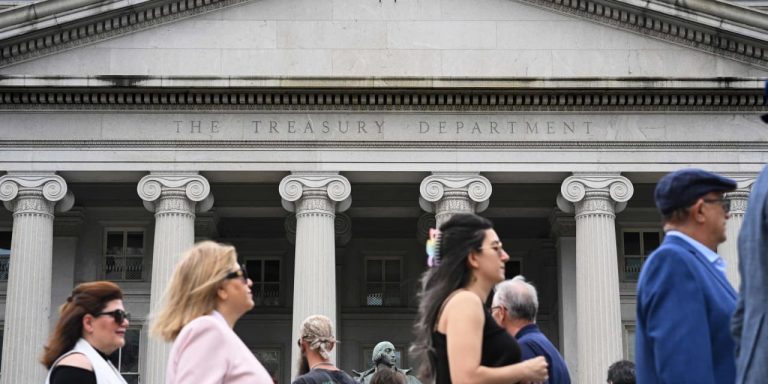Treasury floating-rate securities are gaining appeal—and for good reason. Here, the Treasury building in Washington.
Mandel Ngan/AFP/Getty Images
A once-obscure area of the Treasury bond market is generating significant interest from individual investors this year as they seek to capitalize on high short-term rates.
Treasury floating-rate securities have two-year maturities and have a rate that adjusts each week based on the weekly auction of three-month T-bills. They are an alternative to U.S. Treasury bills.
The current yield on these Treasury floaters, as they are known, is around 5.4%.
Investors can buy them at regular monthly auctions, either through the TreasuryDirect website or banks and brokerage firms. The next auction is on Nov. 21 and is expected to total $26 billion. There are about $600 billion of the floaters outstanding.
An increasingly popular way to play floaters is through two exchange-traded funds: the $18.8 billion
WisdomTree Floating Treasury
ETF (ticker: USFR) and the $10.7 billion
iShares Treasury Floating Rate Bond
ETF (TFLO). The funds are similar and recently yielded about 5.4%, with fees of 0.15% annually.
| Fund / Ticker | Recent Price | Current Yield | Assets (billion) |
|---|---|---|---|
| iShares Treasury Floating Rate Bond / TFLO | $50.62 | 5.35% | $10.7 |
| WisdomTree Floating Rate Treasury / USFR | 50.42 | 5.40 | 18.8 |
Sources: Bloomberg, company reports
Both have experienced large inflows this year, with the WisdomTree ETF taking in over $5 billion and the iShares ETF, more than $6 billion. Both are in the top 10 for bond ETF inflows this year, according to Morningstar.
“Even sophisticated bond investors are surprised” about the floaters and their benefits, says Dhruv Nagrath, a director of fixed-income strategy at BlackRock.
The Treasury began auctioning the floating-rate notes in January 2014 but investor interest didn’t pick up until short rates began to rise in 2022. The BlackRock ETF held just $340 million at the end of 2021, when short rates were near zero.
The Treasury floaters pay a yield premium of about 0.15 percentage point above the T-bill rate, which means a current rate of about 5.4%. They have very little price risk—or an ultrashort duration, in bondspeak—because they reset every week and have a short, two-year maturity. The price range this year for the BlackRock ETF has been just 1%, compared with 25% for the more volatile
iShares 20+ Year Treasury Bond
ETF (TLT).
“They have been one of the few places to hide” during the bond market selloff of 2023, says Kevin Flanagan, head of fixed-income strategy at WisdomTree.
One of the advantages of the floater ETFs relative to the underlying bonds is that investors get monthly income, as opposed to semiannual interest payments on the debt. Interest is exempt from state and local taxes but subject to federal income taxes, like all Treasury debt.
The floaters have benefited this year as short rates have risen and T-bill yields have increased nearly a percentage point to 5.25%. If the Federal Reserve starts to cut short rates at some point in 2024, the rate will start to decline quickly, since it is reset monthly. For now, though, Treasury floaters are riding high.
Write to Andrew Bary at [email protected]
Read the full article here









